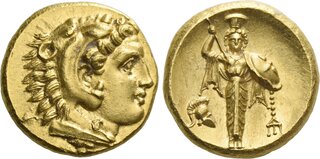| Numismatica Ars Classica > Auction 146 | Auction date: 8 May 2024 |
| Lot number: 2211 Price realized: This lot is for sale in an upcoming auction - Bid on this lot  | Show similar lots on CoinArchives Find similar lots in upcoming auctions on |
| Lot description: Pergamum. Stater circa 334-332, AV 17 mm, 8.60 g. Head of deified Alexander the Great r., wearing lion's skin headdress. Rev. Facing Palladium, wearing calathus on head and holding lance in upraised r. hand and shield on l. arm; in lower l. field, helmet. de Luynes 2493. de Callataÿ, Stateres 2j (this coin illustrated). von Fritze, Pergamon pl. I, 7. Gulbenkian 699. SNG France 1557. Extremely rare and among the finest specimens known. A very attractive portrait of fine Hellenistic style. Virtually as struck and almost Fdc Ex NAC sale 133, 2022, 110. Privately purchased from Nomos in January 2010. This remarkable issue of gold staters presents us with only a fragment of the information usually relied upon to establish a place and date of minting. However, the reverse shows a cultus statue of Athena holding the Palladium, which has led scholars to identify the mint as Pergamum based upon similarities to silver coins of that city bearing an ethnic. The dating of the issue, however, has found less agreement, with published estimates ranging from about 350 to 284 B.C. For many the principal guide is the Saïda hoard, believed to have been buried around the time of the death of Alexander the Great, or soon after. However, the dating of the hoard is not certain, as it relies upon an assessment of other coinages that are not precisely dateable. Furthermore, the hoard has some coins (notably staters of Philippi and Panticapaeum) that warrant caution. Instead, we are perhaps better served by examining the coin type for guidance. If we accept that Pergamum is the mint, a framework can be developed since any suggestion of date would have to make sense in terms of the history of the city. We find an important clue in the head of young Heracles on the obverse, which seems to be inspired by the coinage of Alexander. Though this is by no means guaranteed, since this image had been used extensively before Alexander's time, the style strongly points to Alexander's silver coinage as the source. One cataloguer has indicated this issue was produced by Alexander himself during his southward trek through Asia Minor in pursuit of the Persian King Darius. However, it seems unlikely that at this stage of his campaign Alexander would have issued coinage in Asia without his name; furthermore, if it is considered a transitional issue before the introduction of his 'great coinage' (c.334?), then the obverse of this gold coin would, in fact, be the prototype for Alexander's principal silver coinage. Even less likely is the prospect that it was an issue of Alexander after he had introduced his 'great coinage' since by then it certainly would have borne his name, and there would be no reason for its designs to deviate from the Athena/Nike of his newly established imperial types. Therefore, it is perhaps best to see this as an autonomous issue, regardless of the circumstance. An ideal opportunity was the period 334-332, when the Persian navy sailed the Aegean in an effort to win back the Macedonian gains; meanwhile, Alexander rushed to Phoenicia to capture Persian naval bases in the hope of neutralising this threat. In the midst of this period Alexander defeated the Persians at Issus in November, 333, after which remnants of the Persian army moved northward to try and regain the Macedonian-held inland cities, notably in Lydia. One can imagine that in this tumultuous period, with civic loyalties wavering in a tide of Persian re-conquest, and the uncertainties of Alexander's grand designs, an issue of this type could have been produced at Pergamum. If so, its obverse would express allegiance with the Macedonians and the reverse would invoke protection against the Persians with the help of the Trojan Athena (or the local Athena, represented by a cultus statue in the Temple of Athena on the acropolis of Pergamum). Estimate: 50000 CHF |  |



